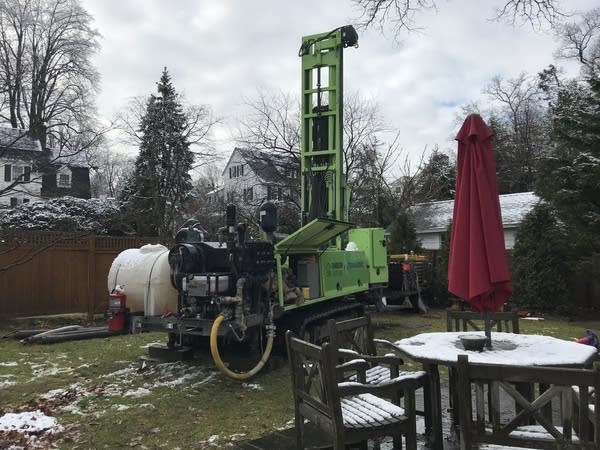Geothermal systems use energy from the Earth to heat buildings. It’s extremely efficient, but only 1% of American households use it.

Geothermal systems let people heat and cool their homes using energy from the Earth. The technology has been around for decades and is incredibly efficient, but fewer than 1% of homes in the U.S. use it. A report out this year from Grand View Research predicts that the market for geothermal heat pumps will increase by more than 7% annually between 2020 and 2027.
Last December, Daniel and Zachary Moore were inching toward that growth, drilling in a suburban backyard outside of New York City. “We’re used to virgin ground up in the middle of a swamp, in the middle of nowhere,” Daniel Moore said. He and Zachary, who are brothers, had been drilling for gold in northern Alaska before they were hired by the startup Dandelion Energy to install geothermal heat pumps. “Here, we have to be a lot more careful and aware of our surroundings.”
They were installing a system at a century-old house in Pelham, New York, and working to maneuver all their drilling equipment up a steep driveway, and into a small backyard. Mike Beilstein bought the house last year.
“When we moved in, there was no insulation in the house, period,” said Beilstein. “It was basically like living in a nice-looking tent.”
Beilstein insulated, and he and his wife also wanted to replace the oil-burning furnace with a more resilient heating system. The local electric utility offers incentives to homeowners who want to install geothermal, which ends dependence on oil or gas and instead relies on an electric heat pump that takes energy from the ground deep underneath the house.
“We can use Mother Earth as our battery,” said Thomas Cronje, who leads drilling operations for Dandelion. “We’ve got this consistent 55 degree Fahrenheit soil. We can, in the winter, use that to transfer heat from the ground to our loops and use it in our homes. And in the summer, transfer all of the heat from our homes.”
Those loops are made of plastic tubes, which Dandelion installs by drilling hundreds of feet deep into the ground. Water flows through the tube, absorbs energy from the ground and transfers it to a heat pump, which then uses it to heat or cool the house.
Dandelion was born at X, Alphabet’s secretive incubation lab. Dandelion split off as its own company in 2017 and is now trying to make it easier for homeowners to install geothermal systems, even if their backyards are tiny. The company wants to do for geothermal heating what Tesla did for the electric car — make it cool.
Getting its system in place is expensive. It costs about $20,000 for the average home. Dandelion gives homeowners the option to finance that. The company has installed 500 systems so far, with a goal of installing about 30,000 by 2026, making inroads into a residential market that has traditionally been hard to tap into.
“People don’t tend to talk about their heating and cooling systems at the coffee shop or at parties,” said Ryan Dougherty with the Geothermal Exchange Organization, a nonprofit trade group. “That’s a barrier, just an awareness barrier that we’ve had to overcome as an industry.”
Dandelion is currently working in Connecticut and New York and sees any homeowner who relies on oil heat as a potential customer. The company was even approached by Starbucks about using geothermal in some of its locations. Kathy Hannun, Dandelion’s founder and president, said it’s a lot easier to get one or two homeowners on board than everyone who’s part of a commercial real estate deal. But she does hope to expand to commercial buildings eventually.
“The market size could not be bigger because every single building, pretty much in the world, heats and cools,” Hannun said.
Others in the field would like to see Dandelion — or another company — standardize installation of geothermal at the community, or district, level.
“It’s essentially taking more than one Dandelion system and putting them all together and saying, I’m going to run this in a neighborhood,” said Jefferson Tester, a professor of sustainable energy systems at Cornell. “If you somehow collectively put it together, there would be some economies of scale.”

A city in the vanguard of geothermal energy, actually, is Boise, Idaho, where roughly a third of the buildings downtown use geothermal systems, but they’re different from those Dandelion installs. Instead of transferring energy from soil and rock, Boise powers its system using water from deep under the city.
“We’re pumping water from very deep aquifers, about 2,000 feet underground. The water comes out at about 177 degrees Fahrenheit, so very hot water. And we pump that through the city,” said Steve Burgos, Boise’s public works director. “And for the buildings that are connected to geothermal, they take that water. They have heat exchangers in their buildings that basically take the heat off the water, and they use that to heat their building.
“And then, we pump the once-used water back into the aquifer, so it goes into the same aquifer that we pulled it out of. So truly it is just one big, eternal loop, which makes it really cool.”
Boise started a version of this in the 1890s. The current system was installed in the 1980s. It is, apparently, the largest geothermal system in the country, and the sixth-largest worldwide, all according to the Idaho Press. And in addition to geothermal energy heating and cooling buildings, some of the older Victorian homes in town have systems that bring hot water from the springs directly into hot tubs.
Correction (December 4, 2020): A previous version of this story misidentified X’s parent company. It has been corrected.